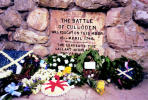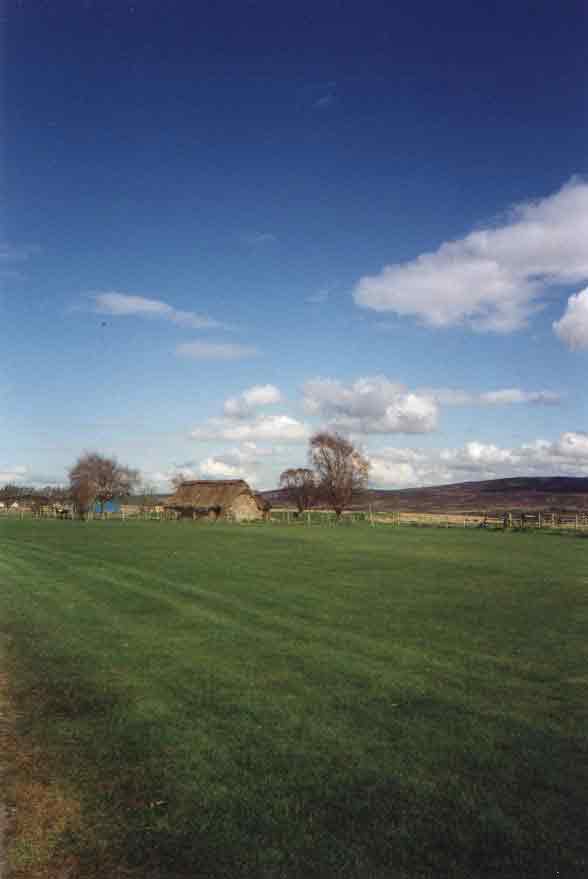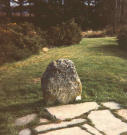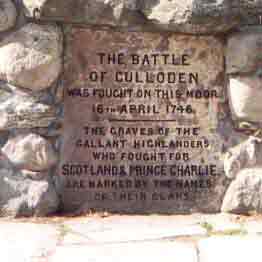Culloden
Lament for Culloden
The lovely lass o’Inverness
Nae joy nor pleasure can she see;
For e'en and morn she cries, 'Alas!'
And aye the saut tear blin's her e'e:
'Drumossie moor, Drumossie day,
A waefu' day it was to me!
For there I lost my father dear,
My father dear and brethren three.
'Their winding-sheet the bluidy clay,
Their graves are growing green to see;
And by them lies the dearest lad
That ever blest a woman's e'e!
Now wae to thee, thou cruel lord,
A bluidy man I trow thou be;
For monie a heart thou hast made sair,
That ne'er did wrang to thine or thee.
(Robert Burns 1759 – 1796)
BY Wijke Ruiter
“The last major battlefield on
British soil” In a tourist guide you’ll find this description
of Culloden Moor, marked on the tourist map with two crossed
swords, meaning “historic battlefield”.
Nothing special - at the first sight - for the unsuspecting foreign
visitor to Scotland. A visitors-centre with a parking place, restaurant
and souvenir shop; all set for a warm welcome to loads of tourists.
In the back of the visitors-center an exhibition immediately attracts
the attention, even the children's. It’s the story about the Jacobites
and their Rise; the Prince and the final battle.
And just at the moment the children's interest wanes – which lets face
it can be quick – there’s another room with weapons, swords and
shields; revival of interest assured!
There's even a little cinema to interpret the story. The visitor centre itself, is much like any other that we find interpreting Scotland's History. Perhaps there's a factory somewhere churning these out.
Leaving the building you’ll enter the battlefield itself. A vague uneasy feeling descends. . Normally outside a museum there’s your own world again; a street with the matching noises; but this is different, your about to step in to a stark reminder of a terrible day in British history. As you make your way in to the battlefield, you cant help wondering why the visitor centre is there at all. For with the help of the boards and plaques that are there the moor can tell it's own story.
On the left a cottage catches
the eye. It’s the Lennach Cottage. The wounded where brought there; a
field hospital of the 18th century. Surgery,
amputations in the worst conditions you can imagine. .
Looking about the field you see
a grassy plain, a red and yellow flag, a path leading up. Then,
wandering around the field the vague feeling grows stronger, there’s
something strange around; the atmosphere. The children wrapped in
silence.
You’re caught in an eternal sadness rising from the grass. As if the soil itself
tells the story.
There are memorial stones, names of the clans, graves of men fighting
for their freedom.
It's over 255 years since the battle. Yet the past seems to reach out
and capture your emotions. On the road, nearby a car goes by and your
back in 2002. It's strange to see the cars rushing past in
the modern world outside..
Horrible things have happened here; beyond every imagination. And
more…it tells about a lost dignity, a lost culture, a lost society, a
lost people. This must be more than just another “historic battlefield”.
And it is. It’s the nations
emotion.
Like Holland has its eighty years war; every Dutch schoolchild can tell
you about it, every Scot must have been brought up with Culloden.
What
happened?
On April 16th 1746 two armies met at Culloden
Moor, known then as Drummossie Muir, some 6 miles from Inverness.
It was the army of Highlanders, the Jacobite Army of Prince Charles
Edward Stuart.The so called pretender to the
throne who claimed the English and the Scottish crown. The army had
made its way to Culloden after a largely successful campaign in to England -which reached Derby.
But argument and indecision led to the decision to turn for home in
endless confusion,
5000 men only, the others were occupied with other missions, or had not
yet returned from their families, taking the opportunity of a
well-deserved rest.
The other army was the Hanoverian Army of the English King George II –
led by the Kings son, Duke of Cumberland.
It was well equipped, armed with heavy cannon and the new, lethal
bayonet. They far outnumbered the Highlanders being 9000 strong.
The battle was over in under
an hour; 1000 to 1500 Highlanders were dead on the field, and
about 700 were taken prisoner; and the Duke was sure of his victory.
He could have had returned home then, as a conquering Hero, the darling
hero of the English nation. He would have received his medals and gifts
poured in to express the gratitude of the boroughs and towns. But he
had butchery in mind.
After the battle an -absolute needless- horrible massacred began;
Hanoverian soldiers had orders to kill the wounded left on the field.
No one was to be spared. Wounded Highlanders were mutilated before
being finished off. They say every human hides a beast, somewhere deep
down, well here’s an example.
Those hidden Hanoverian beasts exploded together with permission of
their leaders, in a gruesome mass hysteria. Giving rein to
indescribable butchery of the wounded.
According to Hanoverian propaganda the Scots were a bunch of half
savages, not evolved primitive axe men; with no culture or social
system at all. In contrast to the feudal system of the English Kings; a
model of a civilized, modern society.
King George’s fight against
the unknown
After this horrible day the
pitiless suppression of a proud nation burst in full violence.
King George fought the “rebels” in his own way; not exactly like an enlightened
despot, but with harsh
terror on a prostrated population. Whole villages were burned to the
ground, cattle were stolen; thousands of crofters were turned off their
land.
But not only physical force was used.
Hereditary jurisdictions were abolished; the
patriarchal authority of the clan chiefs, and the entire chain of
loyalty that depended on them were blown away.
Speaking Gaelic was simply forbidden, as was wearing the kilt.
What was so frightening to the
King then?
The Highland clan-culture was far more democratic and developed than
the English feudal system. It was a system of consultation. Politics
and philosophy are equal in this society. All clan members were trained
in freethinking, deliberation of every situation the clan had to face.
The “think tanks” and brainstorming sessions of our modern
company-management in an ancient form.
Conquering and suppression carry feudal systems; the King simply owned
the land and everything that's on it, even the people.
King George tried to wipe out a social system that he neither
understood nor wanted to.
The King however should have
known, even in this 18th century, that you can terrorize people, try to
oppress a nation, but you can never suppress a way of free thinking, of
philosophizing; proper to the Scots.
This was the strength and resilience of the cut down and wrecked
Scottish society; which came to flourish and the end of the 18th
century. The Scots managed themselves; as they always had done.
The Highland Army before the
battle.
As we know the Jacobite Army had returned from a campaign through
England, relying on support of English Jacobites. The Prince was
convinced he could get that support during his invasion, and would be
crowned as King of England and Scotland.
The Scots however were only interested in their own King in their own
country. It was a campaign of disappointment, although the battles they
fought were won.
The Army returned at Glasgow New Years day 1746. The men were tired of
warfare; the season of planting and sowing waited, many went home.
For the Prince’s most reliable men and trusted friends, like Lord
Murray -the prince’s lieutenant general-, it was obvious that Scotland
would have its autonomy. And the Prince would become their King. The
English had to be expelled from Scottish ground.
The Highlanders would retire in the mountains, fighting guerrilla
warfare, something in which the Scots were specialized.
But the Prince, advised by an Irishman, Lord O’Sullivan preferred to
fight a set piece battle, which would bring him fame, leading to
glorious victory, instead of prolonged pin pricking the enemy.
Guerrilla war needs patience, time and labour; Charles Stuart had none
of that.
No food enough for such
amounts of men.
The duke of Cumberland moved up by the North East Lowland coastal
route, by Aberdeen and then round to Nairn. When the Prince had decided
to engage the enemy he could not wait. Not for a lack of patience, but
the Hanoverian Army had a growing advantage of men and guns.
The Highland Army was suddenly mustered to Culloden Moor; all
contingents summoned to come fast for the final battle awaited. The men
came as fast as they could, and arrived worn out after long days
marches.
And some of the strongest clans were yet to arrive. Just over a half of
the army was present.
There was a huge lack of food; the whole allowance per man for this
date (April 15th) was one small loaf of bannock
– hardly good enough for pigs’ food.
The Prince neglected first rule of warfare: don’t let the men fight on
an empty stomach.
The night before the final battle the Highlander Army was hungry and
exhausted, not a good preparation for such an important battle.
A night-march on Nairn.
During the late afternoon of April 15th 1746,
news was brought to Culloden House -the Prince had retired there – that
the English troops were on their way from Nairn to engage the
Highlanders.
This turned out to be false alarm, and it was learned that Cumberland’s
men were celebrating the birthday of their fat young commander with
rest, good food and plenty of brandy.
A splendid opportunity for a night attack, surprising the enemy in
camp, while they were sleeping off the effects of entertainment.
The night was dark and misty; excellent scene.
But it’s hard to carryout such a nocturnal attack with tired and hungry
men. Some of them left the ranks to find some food. The main body of
the army was unable to keep up with the clans on the first column of
line; the rear was too far back. At one o’clock in the morning the Army
had to have a halt. Slowly it became obvious that the ‘night’ attack
would take place after sunrise, marching
at this speed.
The Army went back to Culloden House, utterly exhausted, with gnawing
hunger and depressing disappointment as a new added emotion.
Day-light
began to appear; they got back at Culloden fairly early in the day, so
that most of the Highlanders had three of four hours rest; but
a considerable number of the clansman, through their great
want of sleep, meat and drink slipped away to Inverness; while others
simply dropped by the roadside to seek sleep.
The fatal day.
Neither Charles nor any of his officers fully
expected Cumberland to advance on that fatal Wednesday morning, April 16th.
The Prince now wanted to withdraw, avoiding battle, an opinion shared
by Lord Murray, but O’Sullivan felt it was too late and every move to
withdraw would result in a pursuit by the enemy.
Food was still virtually non-existent.
Charles was deeply concerned about the state of his
men; hungry and fatigue a few hours before the inevitable battle.
However, in spite of all this discouragements, active preparations were
made for a pitched battle at Drummossie Moor.
Lord Murray said: “Between ten and eleven o’clock we drew up in the
moor, a little back from where we had been the day before. I told Mr.
O’Sullivan, who was placing the men in order of battle, that I was
convinced it was the wrong ground. But he said the moiré was so
interspersed with moss and deep ground, that the enemy’s horse and
cannon could be little of advantage for them.
We still had time to cross the Cairn Water and take up the ground which
two guides had viewed the day before; for our right was within three
hundred paces of the water and the banks were very steep, which was
nothing to hinder Highlanders, and our horse could have crossed a small
ford a mile further back. Cluny
was still marching as quickly as possible, in an effort to join us with
above four hundred men, and many others were hourly expected… So I am
persuaded that that night, or next morning we would have been near two
thousand stronger, and had we passed that water, in all probability we
would not have fought that day. The Duke of Cumberland had encamped
that night upon the moor, which very possibly he might, we would have
had a fair change next day”.
The Battle.
Space
forbids a detailed account of the battle itself. But a few major mistakes have
to be pointed out.
Both the Prince and O’Sullivan ignored Lord Murray’s advice to withdraw
over the Cairn Water, waiting for a far better moment to start the
battle, there were other errors made.
For an outsider a mere detail, but so great an insult sinks deep into
Highland hearts and the MacDonald’s were very incensed.
On the other hand The Atholls, and in particular the Cameron's (who
always fought at the left side) were unwillingly given the ‘right hand
of the field’, an honour enjoyed by the MacDonalds ever since it was
first granted to them by Robert the Bruce at Bannockburn in 1314 –
because Angus Og, Lord of the Isles, once sheltered Bruce in Uist when
he was a fugitive).
Second error was that O’Sullivan wanted to handle the Highlanders like
the orthodox armies of Europe and ordered the clans not
to charge. During such charges however, the Scots Army was at its
strongest.
This mistake was fatal; the entire army endured a cannonade for over an
hour and great lanes were cut in the ranks – the Roy Stuarts, among the
Robertsons, Genbuchat’s half of the Gordons and the Glenmoriston
Grants-.
In short the entire right wing of the Highland front line suffered
casualties as the grapeshot mowed them down.
The object in delaying to charge was to force the Cumberland to leave
his ground and attack. But that did not happen; the cannonade was
murderous enough.
As the destructive fire continued, the Highlanders on the right grew
clamorous to be led to the attack, and Charles at last saw the
necessity of giving orders to charge.
Needless to say that this last desperate charge, however brave and
brilliant performed, was absolute useless, The Highland Army was
already too scattered and too weak.
They reached the first line of the English, an enemy they could feel
but could not see amidst the cloud of smoke. In sheer desperation and
blind recklessness they rushed upon the first line, broke through and
destroyed it. Attacking the second line, the English gave a terrible
fire and most of the clansmen were brought down.
After this final charge the Prince observed
with the deepest concern the defeat and flight of his frontline-clan
regiment. He had seen piece of marvellous –though fatal – bravery.
During the last charge, Keppoch – the Chief of Clan MacDonell of
Keppoch - had been advancing alone while shouting “Mo Dhia an do
thriegh Clan mo chinnidh mi?” (“Have the children of my tribe deserted
me?”). Shortly afterwards Keppoch fell mortally wounded.
The Prince was pretty impressed by this and while standing on the small
eminence where he stood, seeing all this misery, he would have vain
imitated this sublime example of Keppoch.
O’Sullivan, however, after trying every form of entreaty in vain,
forcibly turned the head of the Prince’s horse and dragged him away.
Charles Edward Stuart had left the battlefield; the glory was
Cumberland’s.
The Hanoverian soldiers began their horrible slaughter; blackening this
day in British history.
The simple people of England exulted at the Kings son –nick-named the
Butcher -; Handle wrote:” See the conquering hero come”.
But what was his merit? Did he deserve all that? Had
Cumberland fought the devil single-handed?
Wijke Ruiter
Lochiel,
Lochiel! beware of the day
When the Lowlands shall meet thee in battle array!
For a field of the dead rushes red on my sight,
And the clans of Culloden are scattered in fight.
They rally, they bleed, for
their country and crown;
Woe, woe, to the rider that tramples them down!
Proud Cumberland prances, insulting the slain,
And their hoof-beaten bosoms are trod to the plain.
Campbell.